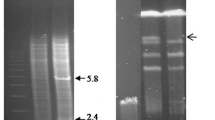Abstract
Genetic transformation of Wangiella dermatitidis was studied using three plasmid vectors (pAN7-1, pWU44, and pKK5) and both electroporation and polyethyleneglycol-mediated methods. pAN7-1 contains the E. coli hygromycin B (HmB) phosphotransferase (hph) gene. Expression of the hph gene confers resistance to antibiotic HmB. Selection for resistance, indicative of transformation, resulted in 10–203 HmB-resistant colonies/μg pAN7-1 on medium containing 100 μg HmB/ml. Strains of W. dermatitidis used in this study have innate sensitivity to HmB at a critical inhibitory concentration of 20–40 μg/ml. Vectors pWU44 and pKK5 contain a URA5 gene from Podospora anserina. A ura5 auxotroph of W. dermatitidis was transformed to prototrophy with pWU44 or pKK5 by complementation. Transformation frequencies for these two plasmids were between 17–50 transformants/μg vector DNA. Southern blotting analysis and polymerase chain reaction detection of DNA from putative transformants confirmed transformation.
Similar content being viewed by others
References
Ausubel FM, Bent R, Kingston RE, Moore DD, Seidman JG, Smith JA, Struhl K (1989) Short protocols in molecular biology. Wiley, New York
Boeke J, Lacroute F, Fink GR (1984) A positive selection for mutants lacking orotidine-5′-phosphate decarboxylase activity in yeast: 5-fluoroorotic acid resistance. Mol Gen Genet 197:345–346
Cooper CR Jr (1989) Induced parasexual genetic analysis of the imperfect pathogenic fungus Wangiella dermatitidis: identification of selected morphogenic and biosynthesis complementation groups. PhD dissertation, University of Texas, Austin
Cooper CR Jr, Szaniszlo PJ (1993) Evidence for two cell division cycle (CDC) genes that govern yeast bud emergence in the pathogenic fungus Wangiella dermatitidis. Infect Immun 61:2069–2081
Cooper CR Jr, Szaniszlo PJ (1994) A spectrophotometric assay for orotidine-5′-monophosphate pyrophosphorylase activity in Wangiella dermatitidis. In: Maresca B, Kobayashi GS (eds) Molecular biology of pathogenic fungi, a laboratory manual. Telos Press, New York, pp 537–543
Diez B, Alvarez E, Cantoral JM, Barredo JL, Martin JF (1987) Selection and characterization of pyrG mutants of Penicillium chrysogenum lacking orotidine-5′-phosphate decarboxylase and complementation by the pyr4 gene of Neurospora crassa. Curr Genet 12:277–282
Fincham JRS (1989) Transformation in fungi. Microbiol Rev 53:148–170
Finkelstein DB (1992) Transformation. In: Finkelstein DB, Ball C (eds) Biotechnology of filamentous fungi, technology and products. Butterworth-Heinemann, Stoneham, pp 113–156
Geis PA, Jacobs CW (1985) Polymorphism of Wangiella dermatitidis. In: Szaniszlo PJ (ed) Fungal dimorphism: with emphasis on fungi pathogenic for humans. Plenum, New York, pp 205–233
Geis PA, Wheeler MH, Szaniszlo PJ (1984) Pentaketide metabolites of melanin synthesis in the dematiaceous fungus Wangiella dermatitidis. Arch Microbiol 137:324–328
Gritz L, Davies J (1983) Plasmid-encoded hygromycin B resistance: the sequence of hygromycin B phosphotransferase gene and its expression in Escherichia coli and Saccharomyces cerevisiae. Gene 25:179–188
Peng M, Singh NK, Lemke PA (1992) Recovery of recombinant plasmids from Pleurotus ostreatus transformants. Curr Genet 22:53–59
Punt PJ, Oliver PR, Dingemanse MA, Pouwels PH, and Hondel CAMJJ van den (1987) Transformation of Aspergillus based on the hygromycin B resistance marker from Escherichia coli. Gene 56:117–124
Roberts RL, Szaniszlo PJ (1978) Temperature-sensitive multicellular mutants of Wangiella dermatitidis. J Bacteriol 135:622–632
Southern EM (1975) Detection of specific sequences among DNA fragments separated by gel electrophoresis. J Mol Biol 98:503–517
Szaniszlo PJ, Momany M (1993) Chitin, chitin synthase and chitin synthase conserved region homologues in Wangiella dermatitidis. In: Maresca B, Kobayashi G, Yamaguchi H (eds) NATO ASI series, vol H69, Molecular biology and its application to medical mycology. Springer, Berlin Heidelberg New York, pp 229–242
Szaniszlo PJ, Jacobs CW, Geis PA (1983) Dimorphism: morphological and biochemical aspects. In: Howard D (ed) Fungi pathogenic for humans and animals, part A (biology). Dekker, New York, pp 323–436
Szaniszlo PJ, Mendoza L, Karuppayil SM (1993) Clues about chromoblastomycotic and other dematiaceous fungal pathogens based on Wangiella as a model. In: Vanden Bossche H, Odds FC, Kerridge D (eds) Dimorphic fungi in biology and medicine. Plenum, New York, pp 241–255
Woods JP, Goldman WE (1993) Autonomous replication of foreign DNA in Histoplasma capsulatum: role of native telomeric sequences. J Bacteriol 175:636–641
Worsham PL, Goldman WE (1990) Development of a genetic transformation system for Histoplasma capsulatum: complementation of uracil auxotrophy. Mol Gen Genet 221:358–362
Author information
Authors and Affiliations
Rights and permissions
About this article
Cite this article
Peng, M., Cooper, C.R. & Szaniszlo, P.J. Genetic transformation of the pathogenic fungus Wangiella dermatitidis . Appl Microbiol Biotechnol 44, 444–450 (1995). https://doi.org/10.1007/BF00169942
Received:
Revised:
Accepted:
Issue Date:
DOI: https://doi.org/10.1007/BF00169942




